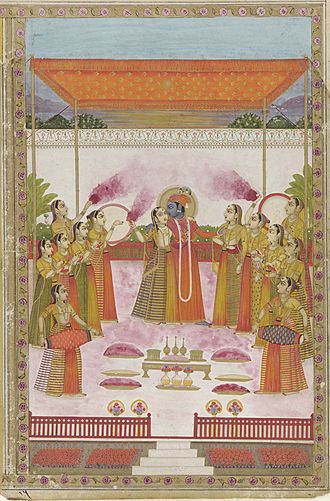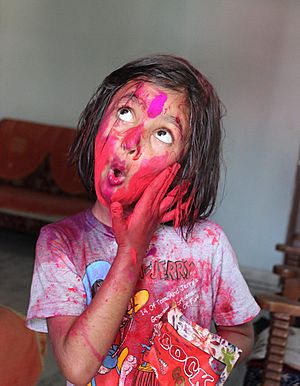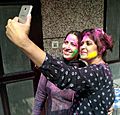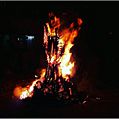Holi facts for kids
Quick facts for kids Holiहोली |
|
|---|---|

|
|
| Observed by | Predominantly Hindus, Sikhs, Jains, Newar Buddhists, and others |
| Type | Religious, cultural, spring festival |
| Celebrations | Night before: Holika Dahan, Kama Dahan On Holi: spraying colored dye, playing with colored powder, dancing, greetings, festival delicacies |
| Date | per Hindu calendar |
| Frequency | Annual |
Holi is a fun and ancient Hindu festival. People call it the "Festival of Love", the "Festival of Colours", and the "Festival of Spring". It celebrates the special love between Radha and Krishna.
Holi also shows that good always wins over evil. It remembers how Lord Vishnu, as Narasimha Narayana, defeated the bad king Hiranyakashipu. This festival started mainly in Nepal and India. Now, people celebrate it in many other parts of Asia and even in Western countries. This is because people from the Indian subcontinent have moved all over the world.
Holi celebrates the start of spring and the end of winter. It is a time for love to grow and for new beginnings. For many, it's a day to meet friends, play, laugh, and forgive others. It also celebrates the start of a good spring harvest season.
The festival lasts for one night and one day. It begins on the evening of the Purnima (Full Moon Day). This full moon happens in the Hindu calendar month of Phalguna, usually around mid-March. The first evening is called Holika Dahan or Chhoti Holi. The next day is known by many names like Holi, Rangwali Holi, Dol Purnima, Dhuleti, Dhulandi, and Phagwah.
Holi is a religious festival for Hindus. But it has become popular with non-Hindus too. Many people in South Asia and other parts of the world celebrate it. Besides India and Nepal, people celebrate Holi in countries like Suriname, Guyana, Trinidad and Tobago, South Africa, and the United Kingdom. In recent years, it has also spread to parts of Europe and North America. There, it is a spring celebration of love, fun, and colours.
Contents
How People Celebrate Holi
Holi celebrations begin the night before the main day. This evening is called Holika Dahan. People gather around a big bonfire. They perform special rituals and pray. They ask that any bad thoughts or feelings inside them be destroyed. This is like how Holika, the sister of the demon king Hiranyakashipu, was defeated in a fire.
Playing with Colours
The next morning is called Rangwali Holi or Dhuleti. This is a free-for-all festival of colours! People playfully smear each other with coloured powders. They also drench each other with water. Many use water guns and water balloons to add to the fun. Everyone is fair game, no matter if they are a friend or a stranger. It doesn't matter if they are rich or poor, young or old.
This colourful fun happens in open streets, parks, and outside temples. Groups of people carry drums and other musical instruments. They go from place to place, singing and dancing.
Visiting Friends and Family
People visit their family and friends. Even people who had arguments come together to throw coloured powders. They laugh, chat, and share special Holi treats. These include delicious food and drinks. In the evening, people dress up in nice clothes. Then they visit more friends and family.
Images for kids
-
The Mughal Indian emperor Jahangir celebrating Holi with ladies of the zenana.
-
Radha and the Gopis celebrating Holi, with accompaniment of music instruments.
-
The Holi Festival in March 2013 at the Sri Sri Radha Krishna Temple in Utah County, Utah.
-
An 1822 drawing showing elevation of a black stone arch in Puri, Odisha. It carried Vaishnavite gods and goddess, the ritual noted to be a part of the Holi festival.
-
Colours for Holi on sale at a market in Mysore
-
Holi celebrated at the Sri Sri Radha Krishna Temple in Utah, United States.
-
Colour drenched gopis in Krishna Temple, Mathura, India.
-
In the Braj region of North India, women have the option to playfully hit men who save themselves with shields; for the day, men are culturally expected to accept whatever women dish out to them. This ritual is called Lath Mar Holi.
-
Preparing for Holika Dahan, Kathamandu, Nepal.
-
Locals celebrating Holi in Kathmandu, Nepal.
-
Holi festival in London, UK near the Battersea Power Station.
See also
 In Spanish: Holi para niños
In Spanish: Holi para niños
























